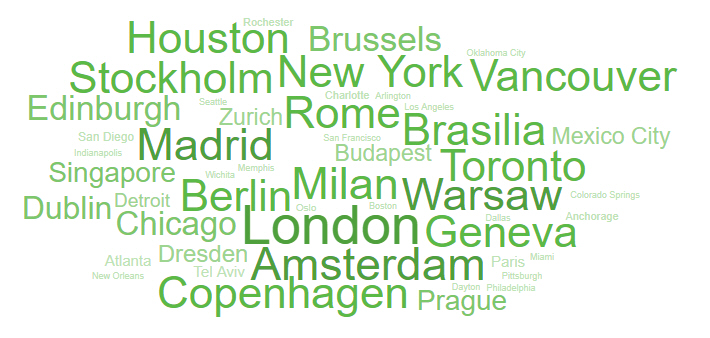Creating Tag Clouds
A tag cloud allows you to see the most frequent or largest values in a dimension field based on the size and color of the text, making it easy to identify the most important values. An example of a tag cloud is shown in the following image.

The following display options are available for a tag cloud:
- Calculation options:
- Summaries. Sums measure values for each sort value. This is the default.
- Counts. Provides a count of records in the selected measure field, for each sort value.
- Details. Displays the value of each individual record.
- Clear buckets content. Empties all buckets.
You can add fields to the following buckets for a tag cloud:
- Detail. The dimension field whose values are displayed as text in the tag cloud.
- Size. A measure value that determines the font size of each value.
- Color. A measure value to set a color scale for the tag cloud text.
- Tooltip. The data placed in this bucket displays in the tooltip at run time. Can be used to make additional information available without changing the appearance of the chart.
- Animate. Enables you to animate time progression using a slider control. As you move the control along the slider bar, an animation effect results. The slider control has a Play button that allows you to play and pause the animation. When you click Play, the Pause option is activated, enabling you to pause the progression and analyze your data. Slider controls are limited to one sort field and should be time or sequence related, such as month or year.
- MultiPage. Enables the creation of multiple graphs based on the field that you place in this bucket. The MultiPage bucket is available for stand-alone charts. If you convert the chart to a page created from new content, the MultiPage bucket disappears.
Procedure: How to Create a Tag Cloud
- Open WebFOCUS Designer. On the WebFOCUS start page, click the plus menu and then click Create Visualizations, or, on the WebFOCUS Home Page, click Visualize Data.
WebFOCUS Designer opens in a new browser tab.
- Select a workspace and a data source available from that workspace.
Once you select a data source, WebFOCUS Designer loads with options to create a single content item.
- On the Content picker, change the chart to a tag cloud.
- Add a dimension field to the Detail bucket and a measure field to the Size bucket. Optionally, add a measure field to the Color bucket.
The tag cloud loads, showing each value of the Detail field with a font size determined by the Size field.
- You can make the following additional customizations to your tag cloud:
- Add additional measures or dimensions to the Tooltip, Animate, or MultiPage buckets of the chart, where applicable.
- Change the fields to obtain different information.
- Format the chart (for example, customize the header and footer).
- Save your tag cloud.
- Release: 8207
- Category: Visualizing Data
- Product: WebFOCUS Designer
- Tags: How-to's
